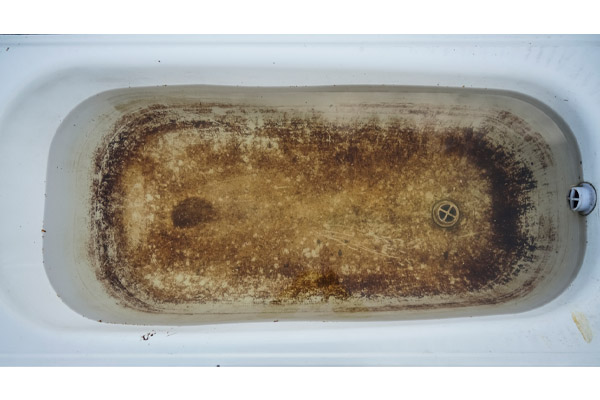We've noticed this article involving Water Coming up Bathtub Drain listed below on the internet and reckoned it made perfect sense to talk about it with you over here.

Sewage back-up in the tub can be a traumatic and unhygienic problem for any type of house owner. Not just is it bothersome, however it likewise presents significant health risks and shows underlying concerns with the plumbing system. Recognizing why sewer is coming up via the tub is vital for taking suitable activity to attend to the problem efficiently.
Intro to the Issue
Typical Factors for Sewer Backup
Clogs in the Sewer Line
One of one of the most usual causes of sewer back-up is a clog in the sewer line. This can occur because of the buildup of debris, grease, or foreign objects in the pipelines, avoiding proper circulation and creating sewage to support into your bathtub.
Tree Root Intrusion
Tree origins seeking wetness and nutrients can penetrate drain lines through small cracks or joints. Gradually, these roots can expand and broaden, causing significant damages to the pipes and leading to sewer back-up issues.
Recognizing the Issue
When sewer starts backing up right into the tub, it's a clear indicator of an issue with the drainage system. The wastewater that ought to be streaming far from your home is instead finding its way back right into your space, which can result in significant damage and carcinogen.
Possible Reasons
Numerous variables can add to sewage backup in the tub. From clogs in the drain line to issues with the plumbing framework, identifying the source is crucial for discovering an option.
Aging Facilities
Older homes may have dated plumbing systems that are much more vulnerable to deterioration, fractures, and wear and tear. As pipelines age, they end up being much more prone to leaks and obstructions, boosting the chance of sewer backup occurrences.
Heavy Rainfall or Flooding
Throughout periods of heavy rainfall or flooding, the drain system may end up being overloaded with excess water, causing back-ups and overflows. This can lead to sewer supporting into tubs and other fixtures inside the home.
Indicators of Sewer Backup
Foul Odors
Unpleasant odors rising from drains pipes or components, particularly in the washroom, may indicate sewage backup problems. These odors are frequently strong and persistent, indicating a problem that needs instant attention.
Slow Draining Fixtures
Tubs, sinks, and commodes that drain slowly or not at all could be experiencing sewer backup. If numerous components are influenced all at once, it's likely that the problem stems from an usual point, such as the main sewer line.
Gurgling Sounds
Odd gurgling or bubbling sounds coming from drains when water is running somewhere else in your home are a measure of air trapped in the plumbing system. This air build-up can result from sewage backup and must be checked out promptly.
Wellness Threats Related To Sewage Back-up
Contamination of Supply Of Water
Sewer back-up can infect the supply of water in your house, positioning a major health threat to you and your household. Exposure to infected water can lead to intestinal issues, skin infections, and various other illnesses.
Mold and mildew Development
Dampness from sewer backup can develop optimal problems for mold and mildew growth in your house. Mold and mildew spores can exacerbate breathing troubles and trigger allergic reactions in sensitive people, making prompt cleanup important.
Spread of Disease
Sewage contains harmful germs, viruses, and parasites that can cause a variety of conditions, consisting of liver disease, cholera, and gastroenteritis. Entering contact with sewage or polluted surfaces places you in jeopardy of infection.
Tidying up After Sewage Backup
Disinfection Procedures
Completely sanitize and sterilize affected locations after sewer backup to remove dangerous microorganisms and prevent mold and mildew growth. Usage suitable cleaning items and safety gear to guarantee secure and efficient cleanup.
Reconstruction of Impacted Areas
Fix any damage to floor covering, wall surfaces, or fixtures caused by sewage backup. Depending upon the extent of the damage, you might need to replace carpeting, drywall, or other products to recover your home to its pre-loss problem.
Immediate Actions to Take
Switching Off Water System
In case of sewage back-up, it's essential to turn off the water system to stop more contamination and damages. Find the main water shutoff valve in your house and shut it off till the concern can be resolved.
Getting In Touch With an Expert Plumber
Taking care of sewage backup is not a do it yourself work. Get in touch with an accredited plumber with experience in managing sewage-related concerns to analyze the scenario and execute necessary repairs or clean-ups.
Preventing Contact with Infected Water
Till the sewage backup is resolved, prevent contact with polluted water to stop the spread of bacteria and microorganisms. Put on protective gear if you must be in the affected location and wash your hands thoroughly afterward.
Safety nets
Normal Upkeep of Sewage System Lines
Set up routine assessments and upkeep of your sewage system lines to identify and deal with potential concerns prior to they intensify into significant problems. This can include cleaning debris, evaluating for tree origin breach, and repairing any damaged pipes.
Installing Bayou Shutoffs
Think about setting up bayou valves in your plumbing system to avoid sewage from receding into your home during durations of heavy rainfall or flooding. These valves instantly close when water draws back up, securing your building from contamination.
Correct Disposal of Home Waste
Stay clear of purging anything other than bathroom tissue and human waste down the commode to prevent blockages and clogs in the sewage system line. Dispose of grease, oil, and various other household chemicals effectively to minimize the risk of plumbing troubles.
Why Is Water Backing Up in My Bathtub When I Flush My Toilet?
What to do about a sewer line clog
First, don’t bother with plunging. No amount of plunging will dislodge the clog in a sewer line. The clog is too far away. Plungers are for clogs in the toilet itself, not the sewer line. Plus, the most likely causes of a sewer clog are:
Tree roots Flushed toys or feminine products Grease buildup Those items don’t move easily. And in the case of tree roots, the roots need to be cut out of the pipe and the pipe will need to be repaired.
You’ll need a closet auger. A closet auger is a type of plumber’s snake with a protective cover to keep from scratching the delicate porcelain toilet. If the clog is further down, you may need to remove the toilet or use one of your cleanouts to get to the clog.
We also recommend doing a video inspection of the drain to ensure that the cause of the clog has been completely removed. Otherwise, you could have the same problem again in a few days or weeks.
https://mspplumbingheatingair.com/blog/why-is-water-backing-up-in-my-bathtub-when-i-flush-my-toilet

Hopefully you liked our topic about What To Do If Sewage Starts Backing Up Into the Shower. Thank you for taking time to browse our content. Appreciated our review? Please quickly share it. Help other people check it out. We take joy in reading our article about Why is Sewage Backing Up Into My Bathtub?.
Course Detail